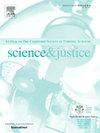Contacting surfaces are rarely DNA Free: Another look at transfer when both surfaces have DNA
IF 1.9
4区 医学
Q2 MEDICINE, LEGAL
引用次数: 0
Abstract
Understanding DNA transfer, persistence, prevalence, and recovery (TPPR) has become increasingly crucial in forensic investigations. Most DNA transfer studies have focused on one-way transfer, neglecting bi-directional exchange. This study examines two-way transfer of blood and touch DNA between plastic and cotton substrates under passive and friction conditions, using methods from previous unidirectional transfer experiments.
Our investigation established statistically significant correlations between bi-directional DNA transfer rates and manner of contact but not substrate type and type of biological material. While, in general, no significant differences were noted between bi-directional and unidirectional transfer rates, significant differences were observed for certain variable combinations where unidirectional transfer resulted in higher transfer rates. This research provides baseline data on bi-directional DNA transfer under semi-controlled conditions, complementing existing unidirectional transfer knowledge. Understanding bi-directional transfer is crucial for accurately modelling DNA transfer events in forensic scenarios, especially for activity level evaluations.
接触面很少是无DNA的:当两个表面都有DNA时,再看看转移
了解DNA转移、持续、流行和恢复(TPPR)在法医调查中变得越来越重要。大多数DNA转移研究都集中在单向转移上,而忽略了双向交换。本研究利用以往单向转移实验的方法,研究了被动和摩擦条件下塑料和棉花基材之间血液和触摸DNA的双向转移。我们的调查在双向DNA转移率和接触方式之间建立了统计上显著的相关性,而不是底物类型和生物材料类型。虽然总体而言,双向和单向转移率之间没有显著差异,但在某些变量组合中,单向转移导致更高的转移率,观察到显著差异。本研究提供了半受控条件下双向DNA转移的基线数据,补充了现有的单向转移知识。理解双向转移对于准确模拟法医场景中的DNA转移事件至关重要,特别是对于活动水平评估。
本文章由计算机程序翻译,如有差异,请以英文原文为准。
求助全文
约1分钟内获得全文
求助全文
来源期刊

Science & Justice
医学-病理学
CiteScore
4.20
自引率
15.80%
发文量
98
审稿时长
81 days
期刊介绍:
Science & Justice provides a forum to promote communication and publication of original articles, reviews and correspondence on subjects that spark debates within the Forensic Science Community and the criminal justice sector. The journal provides a medium whereby all aspects of applying science to legal proceedings can be debated and progressed. Science & Justice is published six times a year, and will be of interest primarily to practising forensic scientists and their colleagues in related fields. It is chiefly concerned with the publication of formal scientific papers, in keeping with its international learned status, but will not accept any article describing experimentation on animals which does not meet strict ethical standards.
Promote communication and informed debate within the Forensic Science Community and the criminal justice sector.
To promote the publication of learned and original research findings from all areas of the forensic sciences and by so doing to advance the profession.
To promote the publication of case based material by way of case reviews.
To promote the publication of conference proceedings which are of interest to the forensic science community.
To provide a medium whereby all aspects of applying science to legal proceedings can be debated and progressed.
To appeal to all those with an interest in the forensic sciences.
 求助内容:
求助内容: 应助结果提醒方式:
应助结果提醒方式:


